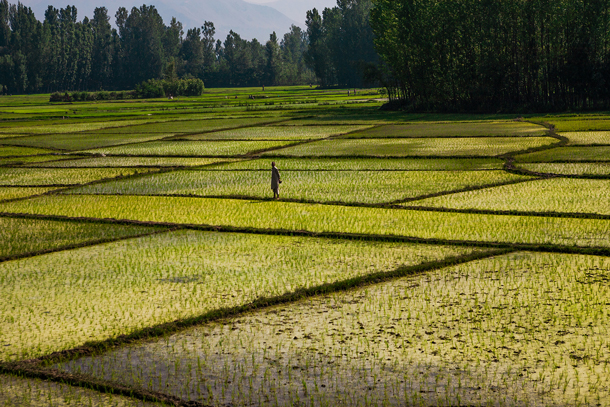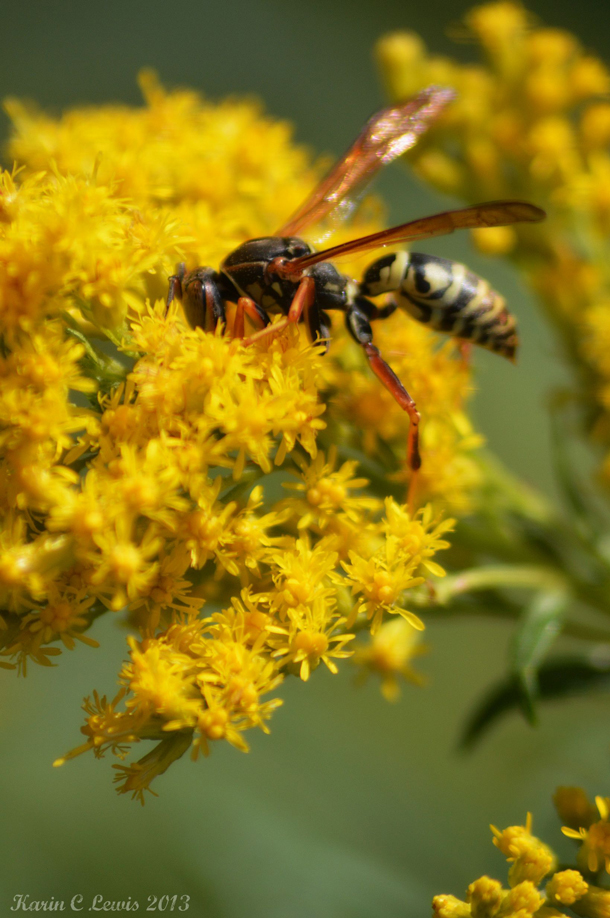Global Warming Threatens Nutrition
Air Date: Week of October 6, 2017

Rice and other staple food crops can lose nutritional value when exposed to elevated levels of carbon dioxide. (Photo: Sandeepa and Chetan Travel Blog (sandeepachetan.com), Flickr CC BY-NC-ND 2.0)
Research is finding that increased atmospheric carbon is harming staple food crops by decreasing their nutritional value. Host Steve Curwood spoke with Harvard scientist Dr. Sam Myers about new research that suggests declining levels of iron, zinc and protein is putting human health at risk, especially in the developing world.
Transcript
CURWOOD: Climate disruption can be tough on agriculture, and now there appears to be another danger to staple crops as carbon dioxide levels rise. Nutrient loss. One expert in this field is physician Sam Myers, who recently published two papers looking at iron and protein levels in plants that get increased amounts of CO2 and how that may impact human health.
Dr. Myers is a Senior Research Scientist at Harvard and a Director at the Planetary Health Alliance. Welcome to Living on Earth.
MYERS: Thanks so much. I'm happy to be here.
CURWOOD: Tell us how you believe this comes about, that increased carbon emissions, and thus more photosynthesis, actually can lead to a decline in nutrients.
MYERS: Well, for starters we're not absolutely sure what it is that's causing the decline in nutrients. So, whether or not it's related to increased photosynthesis, we actually don't know. It may be a direct effect of the carbon on the plants. But what we do know is that when we grow staple food crops at elevated concentrations of carbon dioxide, approximating where the world is going to be in the next 40 years or so, that those staple food crops lose a lot of their nutritional value, and particularly they lose iron, zinc, and protein.
CURWOOD: Give me a sense of just how much nutritional value they lose and why it's significant.
MYERS: So, what we see in a paper we published a couple of years ago in Nature, we showed that staple food crops were losing between five and 10 percent of iron, zinc and protein when grown at 550 parts per million. That sort of leaves a gigantic "So what?" question, which we've been working on for the last two or three years, in which we estimate the diets of the populations of 152 countries, and we model how if they continue to eat the same foods - these reductions of five or 10 percent in these nutrients - how many people would get pushed into risks of nutrient deficiencies which have significant health effects. And what we found were on the order of 150 to 200 hundred million people would be likely to be pushed into those deficiencies, and so that's why I said it’s a significant reduction.
CURWOOD: Yeah, talk to me about how many people around the world are at this point are undernourished or have inappropriate nutrition, in your view, and how your finding compares to that.
MYERS: Well, so there are lots of different kinds of what we call malnutrition. There's too much food, so we obviously have a crisis of obesity, really around the world now. There's too little food which is a caloric problem, and then there are micronutrient deficiencies. And so a lot of the work that we've been doing has been focusing in on those micronutrients, in particular, iron and zinc as well as protein deficiency, and so around the world today there are around two billion people - so, nearly a third of our population - who suffer from micronutrient deficiencies. And so in the studies that we've done we've looked at how many people would become newly deficient, but of course there also are hundreds of millions or billions of people who would have their deficiencies further exacerbated.
CURWOOD: Talk to me about the health effects of these nutrient deficiencies - zinc, iron and so forth.
MYERS: So, for zinc, the burdens of disease from zinc deficiency are calculated for children under the age of five, and zinc is an important component of our immune systems, and so what we've found is that children that have adequate zinc levels will die in much lower numbers from common infections like malaria, pneumonia, diarrheal disease. And so when you look at what are called the relative risks, the risks of dying from those diseases, they're much higher in children who are zinc deficient.
For iron deficiency, there's a broader array of health effects. So, pregnant women die in higher numbers giving birth. There's higher neonatal mortality, meaning death of infants at birth or soon after. You get reductions in IQ and intelligence, reductions in work capacity, so there are a variety of effects from inadequate iron intake.

Researchers at the USDA found that Goldenrod, an important source of food for pollinators, has already shown a 30% decline in protein value since the middle of the 19th century, and it’s apparently linked to rising CO2 levels. (Photo: Karen Lewis, Flickr CC BY-NC-ND 2.0)
CURWOOD: Can you briefly explain for me, how you measure these nutrient levels in different parts of the world? The methodology you used, Sam.
MYERS: So, it's sort of been a two-step process. The first step is very direct, which is to grow staple food crops in open fields at elevated concentrations of carbon dioxide. And so, if you imagine an open field in the middle of the field is a ring of carbon dioxide emitting jets and you grow a specific cultivar of a specific crop, like wheat or rice, and outside the ring you grow the identical cultivar in the same soil, the same conditions, but at ambient, at regular, CO2 levels, and you compare the nutrient content of the crops inside the ring where the CO2 is high versus outside the ring, and that's sort of step one which allows you to estimate how much nutrient is changing as a result specifically of the CO2 effect.
The second step is to estimate how much of these different foods people are eating, and to do that we had to build something called the global expanded nutrient supply database, which is a database of the per capita consumption for 152 different countries of 225 different foods with their nutrient densities which we then use to model the total intake of things like iron and zinc for the populations of each of these 152 countries under today's CO2 conditions and under the CO2 conditions we anticipate by the middle of the century, and then you can look at the difference.
CURWOOD: Sam, where is this going to be the biggest problem? What parts of the world are going to be facing these kind of nutrient deficiencies?
MYERS: Well, so the deficiencies themselves are going to be most severe in South Asia and in Africa. In particular, India appears to be very vulnerable to these changes. We estimate about 50 million people in India alone would become protein deficient as well as the large numbers of people who are already protein deficient, and throughout Africa. And it's really a question of what their underlying diets are. So, people that have very little animal source food in their diet and are relying on crops like wheat and rice for large amounts of their iron, zinc, and protein intake, those are the most vulnerable populations.
CURWOOD: Sam, you're talking about parts of the planet are going to have a lot of trouble from climate disruption, especially with drought or crazy monsoon seasons. We're already seeing in Africa and India problems with growing crops now.
MYERS: There's no question that certain parts of the world are going to be particularly vulnerable, and one of the issues that this kind of work, I think, brings into very sharp contrast is an issue of equity and social justice. Because if you think about where the carbon emissions are going to come from between now and 2050 or so, to get us to 550 parts per million, and then you think about who is going to be vulnerable to those rising CO2 levels and experience nutritional deficiencies as a result, they're almost mirror images of each other. And so it's really the wealthy people in the wealthier parts of the world that are emitting much higher levels of carbon dioxide, and it's the poorer people in the poorer parts of the world that are suffering the consequences. And so, it really does become an issue of social justice, to think about how we take better care of those vulnerable populations.
CURWOOD: Dr. Myers, as you know, we began the present era around 275 parts per million of CO2. We're up to 400 now. Your research looks at 550, but to what extent might we be experiencing this loss in nutrient density even now with an increase in CO2?
MYERS: So, it's a wonderful question. Essentially, if you think about how we would answer that question retrospectively, the easiest thing we could do would be to look for archived samples of grain, for example, that had been grown at an earlier time when carbon dioxide levels were lower. And the problem with that methodologically is that the cultivars that we grow, things like wheat and rice and soybeans, are changing on average every three or four years, and so there isn't a longitudinal series, there isn't a single cultivar that we can track over time that way. And so what we do know is that nutrient contents have been falling in crops for decades, and you know, some of that is probably just that we've been breeding crops to be very high yielding without a lot of concern about their nutrient content. So some of that may just be a result of our breeding program, and some of it may be a result of CO2.

Sam Myers MD is a Senior Research Scientist at the Harvard T.H. Chan School of Public Health and the Director of Planetary Health at the Planetary Health Alliance. (Photo: courtesy of Sam Myers)
But there was a wonderful piece of research that was done I think a year or two ago by my colleague Lou Ziske at the U.S. Department of Agriculture in which he did that analysis but not for food crops. Instead he looked at goldenrod, and it turns out that there are herbaria around the country that have been archiving specimens of goldenrod going back to the 1850s. And goldenrod is actually a very important plant for pollinators, particularly bees, because it's late flowering plant flowers in the autumn and gives bees a lot of the pollen that they need over winter. It feeds them before they become dormant. And so he looked at the pollen itself from goldenrod flowers going back to, I think it was 1851 or so, and what he found was that there's been a 30 percent reduction in the protein content of the goldenrod pollen between then and now. He then set about to actually reproduce that data in the laboratory by growing goldenrod at different carbon dioxide levels, and he showed that reproduce it perfectly and it was essentially a linear relationship, that, as CO2 was rising, the protein content in the goldenrod pollen was falling. And so we do have that sort of anecdotal evidence to suggest that there may well be a linear effect and that we may well already be suffering the effects of rising carbon dioxide on the nutrient content of plants.
CURWOOD: What are some of the possible solutions to this crunch that's coming, declining nutrient value with increased CO2 and other effects from climate disruption?
MYERS: Well, I mean, on the first solution is to stop emitting so much carbon dioxide. So, in public health we talk about primary prevention. That would be primary prevention. So, we need to think hard about ways that we can decarbonize our energy economy as quickly as possible.
Secondary prevention would be things like bio-fortification of crops. So, developing crop types that are enriched with respect to these nutrients, like iron and zinc and protein, or breeding crops that are less sensitive to the CO2 effect and there's some reason to believe that might be possible over time.
Many of these vulnerable nations would do well to think about ways that they can increase dietary diversity, so that their populations are consuming a wider variety of foods that give them a stronger nutritional base. So, the first thing is to get countries recognizing that this is a threat developing as we speak and that they need to think about what's most appropriate for their particular populations.
CURWOOD: Physician Sam Myers is a senior research scientist at the Harvard TH Chan School of Public Health and Director of Planetary Health at the Planetary Health Alliance. Thanks so much for taking the time with us today, Sam.
MYERS: It's a great pleasure to speak with you. Thank you.
Links
Protein deficiency study from Environmental Health Perspectives
Iron deficiency study from GeoHealth
Listen to our previous interview with Dr. Sam Myers, “CO2 can reduce food value”
Living on Earth wants to hear from you!
Living on Earth
62 Calef Highway, Suite 212
Lee, NH 03861
Telephone: 617-287-4121
E-mail: comments@loe.org
Newsletter [Click here]
Donate to Living on Earth!
Living on Earth is an independent media program and relies entirely on contributions from listeners and institutions supporting public service. Please donate now to preserve an independent environmental voice.
NewsletterLiving on Earth offers a weekly delivery of the show's rundown to your mailbox. Sign up for our newsletter today!
 Sailors For The Sea: Be the change you want to sea.
Sailors For The Sea: Be the change you want to sea.
 The Grantham Foundation for the Protection of the Environment: Committed to protecting and improving the health of the global environment.
The Grantham Foundation for the Protection of the Environment: Committed to protecting and improving the health of the global environment.
 Contribute to Living on Earth and receive, as our gift to you, an archival print of one of Mark Seth Lender's extraordinary wildlife photographs. Follow the link to see Mark's current collection of photographs.
Contribute to Living on Earth and receive, as our gift to you, an archival print of one of Mark Seth Lender's extraordinary wildlife photographs. Follow the link to see Mark's current collection of photographs.
 Buy a signed copy of Mark Seth Lender's book Smeagull the Seagull & support Living on Earth
Buy a signed copy of Mark Seth Lender's book Smeagull the Seagull & support Living on Earth

